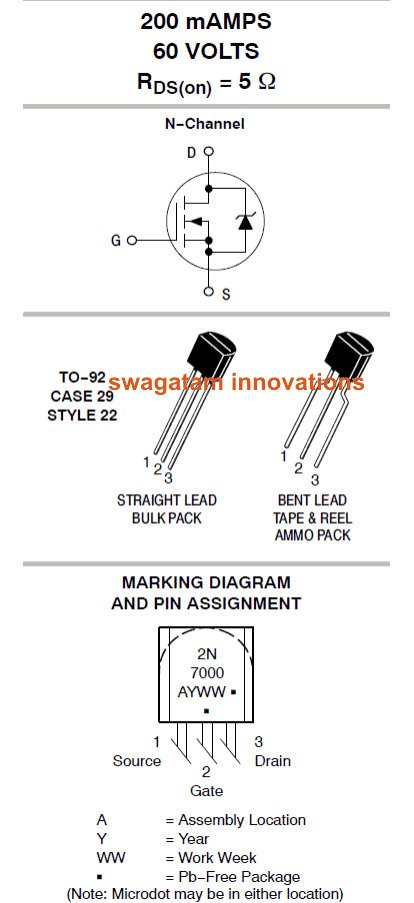In this post I have explained the main specs and pinouts of a small signal, low power N-channel mosfet 2N7000G.
Mosfets vs BJTs
When we talk of mosfets we normally associate it with high current, high voltage, and with high power applications.
However, just like ordinary BJTs, small signal mosftes are also available which may be as effectively used as their BJT counterparts.
Mosfets are popular for their extremely high power delivering capabilities yet being smaller with their overall dimensions.
Unlike the BJTs, mosfets would handle huge currents and voltages without getting bigger itself in size and without involving intermediate buffer stages or high current driver stages.
How Mosfet is Triggered
The biggest advantage of using a mosfet is that, it can be triggered as desired for operating a given load irrespective of the gate drive current.
The above feature allows mosfets to be triggered directly from low current sources such CMOS or TTL outputs without the need of buffer stages, a big difference when compared with BJTs.
The above feature also applies to small signal mosfets which can be directly replaced for small signal BJTs such as a BC547 for acquiring much efficient results. One such small signal mosfet datasheet, specification is discussed here.
It’s the N-channel 2N7000G mosfet, typically suited for small signal applications in the range of 200mA and 60V maximum.
The On state resistance across its drain and source terminals is typically around 5 ohms. The mains features of this small signal, low power mosfet is listed below:
Main Electrical Features:
Drain to source voltage Vdss = 60V DCGate to Source voltage Vgs = +/- 20V DC, +/- 40V DC peak non-repetitive, not exceeding 50microsecondDrain current Id = 200mA DC continuous, 500mA pulsed
Total power dissipation Pd at Tc = 250 C(junction temp) = 350 mW The pinouts, and package details can be seen here:



Have Questions? Please Leave a Comment. I have answered over 50,000. Kindly ensure the comments are related to the above topic.